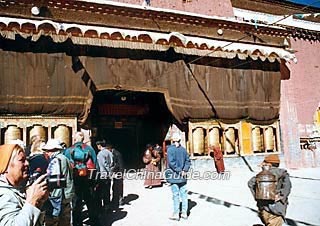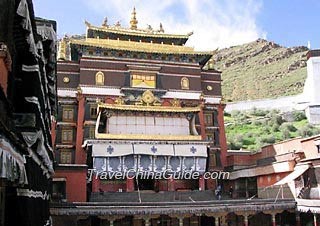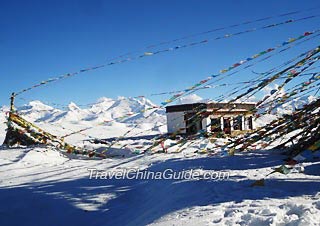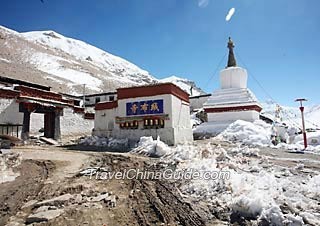Shigatse Travel Guide
Shigatse Facts
Chinese Name: 日喀则 (rì kā zé)
Population: 870,700
Area: 182,000 square kilometers (about 70,270 square miles)
Location: in the southwest of Tibet, southwest China
Administrative Division: 1 municipal district (Sangzhuzi), 17 counties (Jiangzi, Bailang, Lazi, Sagya, Gangba, Dingjie, Dingri, Nyalam, Kangma, Yadong, Buren, Nanmulin, Xietongmen, Jilong, Angren, Saga, Zhongba)
Area Code: 0892
Zip Code: 857000
GDP (2019): CNY 27.949 billion (USD 4.051 billion)
Nationalities: Tibetan, Han, Hui, Mongolian
Tibet’s Second-Largest City Famous for Everest and Majestic Monasteries
Shigatse, also named Xigatse, means 'the fertile land'. It sits in the plain at the confluence of the Yarlong Tsangpo and Nyangchu Rivers, where Tibet's most fertile land is to be found. It borders Ngari to the west, Nagqu to the north, Lhasa and Shannan to the east and shares boundaries with Nepal, Bhutan and India. It is about 276 kilometers (171 miles) from Lhasa. The city has a history going back more than 600 years and it is the traditional seat of the Panchen Lama, one of the spiritual leaders in Tibet.
Shigatse has become one of the most attractive tourist destinations in Tibet due to its ancient culture, majestic monasteries, magnificent natural landscape, and superior geographical location. Going upstream from Lhasa along the Yarlung Zangbo River and passing through the Yamzho Yumco Lake, you will enter the Shigatse region. Continue to the south and you will reach a beautiful glacier world and the world's highest peak Everest. It is 150 kilometers (about 93 miles) away from the Sakya Monastery. Then go west to the Zhangmu Port, the gate to Nepal, where you can purchase exotic commodities from Southeast Asian countries.
See more: Mount Everest Hiking
As one of the world's highest cities with beautiful high plateau scenery, the area is also a hot spot for Chinese tourism. Its long history gives this city a strong cultural heritage, especially in respect of Buddhism. The approximately 600 year-old majestic Tashilhunpo Monastery has a magnificent architectural style with a golden roof and resplendent buildings. Dozens of monasteries belonging to different sects enhance the atmosphere of Buddhism. Various grand festivals like Buddha Unveiling Festival in the monasteries each year give people a chance to admire the huge portraits of three Buddhas.
|
|
In terms of transportation, there are tourist buses heading for the nearby venues such as Lhasa, Zhangmu and Nakchu. No.318 National Highway and the China-Nepal Highway. These connect Shigatse with the outside world while opening up the outside world to people living here. Nowadays, the area is an important Tibetan communication hub and an air of modernization pervades the area. New industries including mechanics, chemicals and food production thrive here. Meanwhile, the traditional handcrafts have been encouraged and expanded. Products such as Tibetan knives as well as items of silver and gold are sought after throughout China and are exported abroad.
See also Shigatse Railway Station
|
|
7-Day Shigatse Weather Forecast
![]() History: Before the 1950s, the region remained in a primitive state in terms of its economy and its people's lifestyle. Following reformation and the opening up to the modern world, a series of highways were built up.
History: Before the 1950s, the region remained in a primitive state in terms of its economy and its people's lifestyle. Following reformation and the opening up to the modern world, a series of highways were built up. ![]() Local Highlights: In the city, hotels and motels of different classifications satisfy visitors' needs. Although the accommodation in this remote area cannot be compared with those in modern cities, they are still important and plentiful.Public amenities such as the post office and banks do much to facilitate travel in Tibet.
Local Highlights: In the city, hotels and motels of different classifications satisfy visitors' needs. Although the accommodation in this remote area cannot be compared with those in modern cities, they are still important and plentiful.Public amenities such as the post office and banks do much to facilitate travel in Tibet.
![]() Related Hiking Itineraries Information:
Related Hiking Itineraries Information:
Shigatse Sightseeing: 3-day Visit
Shigatse In-depth: 3-Day In-depth Exploration
Shigatse Exploration: 2 Days Monastery Tours![]() Further Reading:
Further Reading:![]() Dinning
Dinning ![]() Shopping
Shopping



